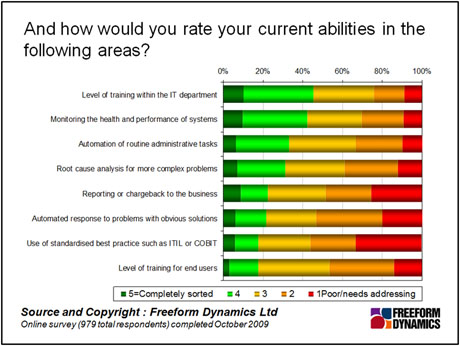In an earlier article in this workshop we considered the challenges associated with procuring system management technologies. We know from our research amongst IT administrators that making a business case for systems management tools is rarely straightforward, even when major changes in the infrastructure or the way services need to be delivered to users is undergoing change.
Increasing the automation of systems management by using these management tools holds out the promise of significant benefits and aids the creation of a business case, but are we ready to trust software to automate the administration of critical, or even major components, of the IT service delivery infrastructure?
Insight we have gathered around the management of x86 server estates illustrates that IT staff are under considerable pressure. Over half of all organisations with more than 50 staff reported that management operations are challenging due to over stretching operations staff. The same report tells us that only about a quarter of organisations have management capabilities standardised on one or two integrated systems management suites.
Automating routine processes has the potential to free up valuable staff time as well as opening the possibility to relieve the “overstretch” we mentioned earlier. It can also delay significantly, or even remove, the need to employ additional staff. The latter benefit is clearly a matter that helps at a time when IT spending is under very tight control. It also assists when making a business case when increases in operational budgets are difficult to justify, and for which it is even harder to garner approval.
This is interesting when we consider the current use of tools to automate systems management processes. The figure below highlights that few organisations make extensive use of automation. As can be seen only around ten percent of organisations consider that they have sorted out the automated response to problems with obvious solutions. It is likely that the number automating the response to more complex operational issues is even smaller, especially as the implementation of “root cause” analysis tools and service level monitoring systems is still at a relatively low level.

Many IT vendors are now talking up their ability to help automate routine tasks and even to help “repair” simple service management problems without the manual intervention of IT staff. Indeed, talk of the “lights out” running of systems is sometimes posited to be the ultimate “nirvana” state of the future for IT operations.
Clearly this state of affairs is nowhere near ready for practical implementation in the daily IT operation of any organisation. But the question to be asked is just how much manual labour is required today if best practice and modern management tools are to be employed to the full? The answer is that many routine tasks can be operated with little or no manual intervention. Indeed, it is even possible for system provisioning to be almost fully automated in response to a user request, a matter well illustrated by the way that many consumers gain access to certain web services. This automation of service provisioning is gaining a foothold in business but there does appear to some resistance to be overcome, with a fair dose of technological objections or issues combined with both business inertia and political wrangling.
I know from my own experiences as a systems manager that few IT professionals are comfortable with the full automation of any process run by management tools. And nor should they be comfortable – such an approach would constitute a big risk, and systems manager are paid to manage the risk effectively. However, it is possible to automate where it makes sense and still maintain good oversight of risk.
Even when the tools have been used without incident for some time, there are many administrators who wish to still hit the “yes” key to allow a systems management tool to make any change or initiate a process, thereby still avoiding “full automation”. A good approach to take would be to combine operations experience with automation to allow managers to maintain a watching eye on operations and control without always having to say “yes”, i.e. raising the flag where appropriate. In this way it should be possible to gain confidence in the automation tools and then gradually shift responsibility to them over time, always keeping an effective process on hand for exception handling and manual escalation.